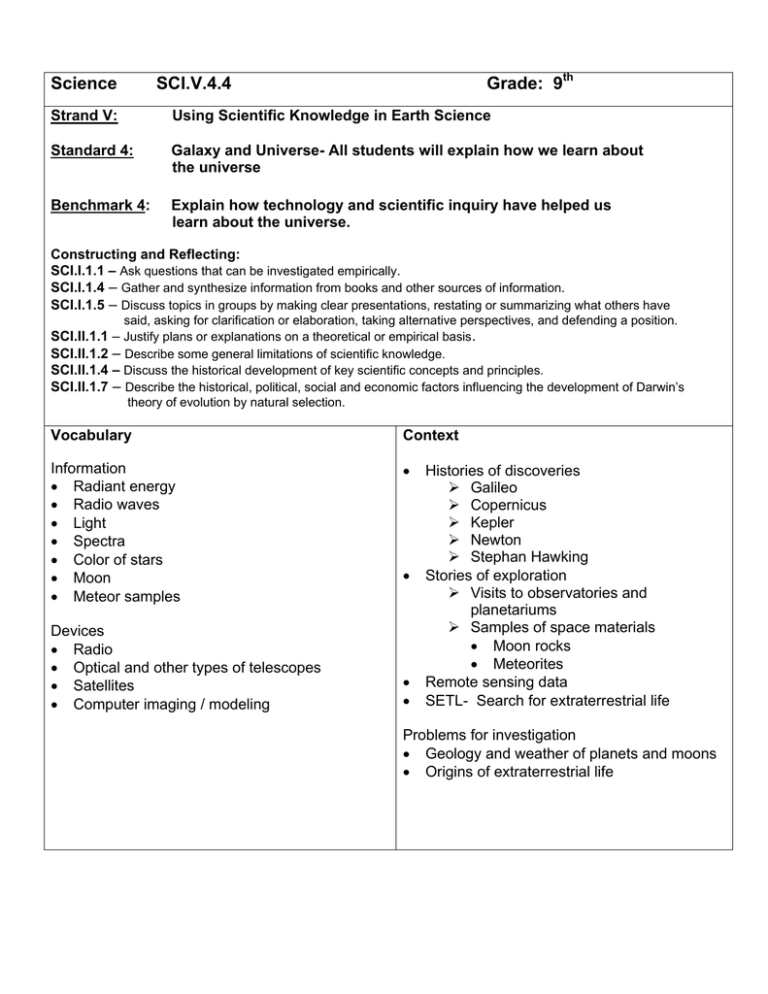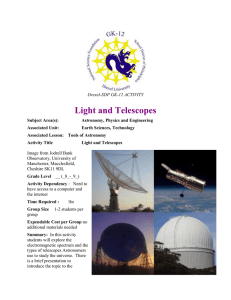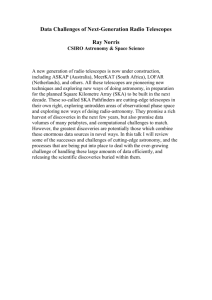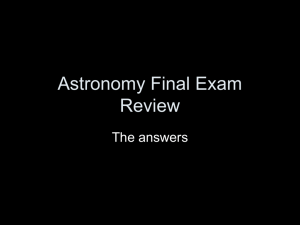Science SCI.V.4.4
advertisement

Science Grade: 9th SCI.V.4.4 Strand V: Using Scientific Knowledge in Earth Science Standard 4: Galaxy and Universe- All students will explain how we learn about the universe Benchmark 4: Explain how technology and scientific inquiry have helped us learn about the universe. Constructing and Reflecting: SCI.I.1.1 – Ask questions that can be investigated empirically. SCI.I.1.4 – Gather and synthesize information from books and other sources of information. SCI.I.1.5 – Discuss topics in groups by making clear presentations, restating or summarizing what others have SCI.II.1.1 SCI.II.1.2 SCI.II.1.4 SCI.II.1.7 said, asking for clarification or elaboration, taking alternative perspectives, and defending a position. – Justify plans or explanations on a theoretical or empirical basis. – Describe some general limitations of scientific knowledge. – Discuss the historical development of key scientific concepts and principles. – Describe the historical, political, social and economic factors influencing the development of Darwin’s theory of evolution by natural selection. Vocabulary Context Information • Radiant energy • Radio waves • Light • Spectra • Color of stars • Moon • Meteor samples • Devices • Radio • Optical and other types of telescopes • Satellites • Computer imaging / modeling • • • Histories of discoveries ¾ Galileo ¾ Copernicus ¾ Kepler ¾ Newton ¾ Stephan Hawking Stories of exploration ¾ Visits to observatories and planetariums ¾ Samples of space materials • Moon rocks • Meteorites Remote sensing data SETL- Search for extraterrestrial life Problems for investigation • Geology and weather of planets and moons • Origins of extraterrestrial life Resources Knowledge and Skills Students will: • • • Explain how technological advances have allowed us to test our hypotheses and to expand our knowledge of the universe Coloma Resources: Glencoe CH 28.1 Tools of Astronomy Glencoe MiniLab Pg 111 The Suns Position Other Resources: • Explain how the remoteness of objects in the universe necessitates the use of sophisticated technologies to make even basic • observations. Explain how various technologies such as radio, optical and other types of telescopes, space probes, satellites, computer imaging/modeling, spectroscopes, and charged-coupled devices allow scientists to gather data about the universe. Science Olympiad- Reach for the Stars • Channel One movie Videoconferences Available For more information, see www.remc11.k12.mi.us/dl or call Janine Lim 471-7725x101 or email jlim@remc11.k12.mi.us V.4.HS.4 Galileo from Historically Speaking... Design a Space Explorer from the Liberty Science Center From Rockets to the Red Planet: Space on Television from the Museum of Television and Radio Apollo Moon Landings - Fact, Not Fiction from NASA Glenn Research Center Exploring Mars: Parts 1-5 from NASA Glenn Research Center Galileo Mission to Jupiter from NASA Glenn Research Center Space and the Solar System from NASA Glenn Research Center The Moon from NASA Glenn Research Center Galileo from ViREnt Broadcasting Adler Planetarium — Weather Watch. http://www.adlerplanetarium.org/ • Scope Unit – Solar System, Galaxy and Universe • Bradford Robotic Telescope. http://www.telescope.org • Culturally Relevant Materials for Science • Current Information about Weather from Outer Space. MESTA, 2000.3. http://www.windows.umich.edu/spaceweather/ • Hubble Telescope Site — Science and Technology. http://hubblesite.org/sci.d.tech/ • News/entertainment to budding astronaut/astronomers. http://www.spacekids.com/ • NASA — human space flight. http://spaceflight.nasa.gov/index.html • NASA — Star Trails Society. http://www.startrails.com/ • NASA — Solar System Simulator. http://space.jpl.nasa.gov • Space Telescope Science Institute — Instruments. http://www.stsi.edu/hst_overview/instruments • The Sky at Many Wavelengths. Astronomical Society of the Pacific (slide show). • Apollo 13 Movie Other Resources:(continued from column at right) • Michigan Teacher Network Resources http://mtn.merit.edu/mcf/SCI.V.4.HS.4.html Assessment Instruction The teacher will present the following scenario: Imagine that Benchmark Question: How do we study distant objects such as our Moon, other planets, you are part of a team of scientists from a major university. You need to prepare a speech for a congressional hearing the Sun, and other elements in the universe? on funding for the space program. You have been asked to Focus Question: How have technological prepare answers to the following questions: advancements changed our view of the sky? 1. What is the advantage of putting telescopes of each type Students will divide into small groups and each (radio, microwave, infrared, visible, ultraviolet, X-ray, gamma) in space rather than operating them from the will investigate the historical development of bottom of the Earth’s atmosphere? several types of telescopes, including types of optical telescopes, infrared telescopes, radio 2. Which types of telescopes are used effectively from the telescopes, ultraviolet telescopes, microwave bottom of the atmosphere? telescopes, and X-ray telescopes. After placing these critical developments in chronological order (perhaps they could be displayed on a timeline), students will view slides of what our sky looks like in these same spectral bands in the same order. Each student should sketch and compare the general characteristics of the sky in each of the spectral bands. Each student will write an essay explaining how the Milky Way Galaxy appears in these views. And if it is indeed a spiral galaxy, why it appears as a thin line when viewed on its edge. The teacher will present information about people of diverse cultures who have made significant contributions to science, because many of these contributions have not been recognized. Students will collaboratively research different technological advancements in the field of astronomy and present the findings. Corresponds to standard I.1.3, I.1.4, II.1.1, II.1.4, & II.1.7 3. What are the advantages to scientific knowledge of using many different types of telescopes rather than just one? Students will work as teams and research telescopes in order to prepare answers to these questions. One team will sit in the front of the room and act as congressional representatives while the other teams present their findings. The congressional representatives will evaluate each team on the persuasiveness of their arguments as well as the teams’ understanding of telescopes. Students should demonstrate their understanding of the following key concepts: 1. A telescope above the atmosphere is not hampered by atmospheric interference. 2. Radio telescopes can be effectively used at the bottom of the atmosphere, but other types are limited by interference. 3. Optical telescopes can be effectively used at the bottom of the atmosphere, but other types are limited by interference. 4. Combining data from different types of telescopes gives a more complete view of the universe. Criteria Apprenti Basic Meets Exceeds Understandi Shows ng of key understan concepts ding of one key concept. Shows understanding of two key concepts. Shows understan ding of three key concepts Shows understandi ng of four key concepts. Persuasiven Not very ess of persuasive argument argument with little support and few logical reasons. Somewhat persuasive argument supported by some logical reasons. Quite persuasiv e argument supported by logical reasons. Very persuasive argument supported by logical reasons. Teacher Notes: Comparing and contrasting our planet and the sun to other planets and star systems Students' understanding of the solar system, galaxy and universe begins with understanding our sun, earth, and moon system. In the earliest grades, children can be introduced to the concepts that the earth is a planet, the sun is a star and the earth orbits the sun. Research with children tells us that the ideas that our sun is a star and that the earth orbits the sun are difficult ideas for students to understand. Observations of the moon may include the identification and prediction of moon phases. These observations provide first hand experiences for students to which they can tie their subsequent learning. Repeated in the middle school years, these same observations might be extended by telescopes or binoculars and include other space objects such as other planets and their satellites, stars, constellations, and comets.




